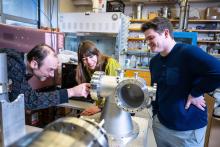An inventive update to an astronomy course at UBC is giving students a hands-on feel for the scale, structure and motion of the Solar System.
The Human Orrey Project--supported by UBC's Carl Wieman Science Education Initiative--involves 40 students placing sticky notes on the floor of the Irving K Barber Learning Centre to trace the orbits of Mercury, Venus, Earth, Mars, Jupiter and Saturn.
Students then take turns acting as the planets in orbit, while another team maps out other planets along with the Voyager spacecraft, the most distant man-made object. The third-year course is designed for non-science students at the university.
"We want our students to personally experience the scale and structure of the Solar System," says Peter Newbury, a Science Teaching and Learning Fellow working with the course's instructor and the CWSEI to incorporate new and proven learning methods in astronomy courses.
The CWSEI is a $12 million initiative headed by Nobel Laureate Carl Wieman aimed at systematically improving and scientifically measuring the effectiveness of undergraduate science education.
Typically staged outdoors, the UBC Human Orrery Project this term is being held in the newly completed Irving K Barber Learning Centre. The project is also part of worldwide celebrations of 2009 as the International Year of Astronomy, in commemoration of Galileo’s first use of a telescope to explore the sky in 1609.
Musqueam First Nation land acknowledegement
We honour xwməθkwəy̓ əm (Musqueam) on whose ancestral, unceded territory UBC Vancouver is situated. UBC Science is committed to building meaningful relationships with Indigenous peoples so we can advance Reconciliation and ensure traditional ways of knowing enrich our teaching and research.
Learn more: Musqueam First Nation
Faculty of Science
Office of the Dean, Earth Sciences Building2178–2207 Main Mall
Vancouver, BC Canada
V6T 1Z4


